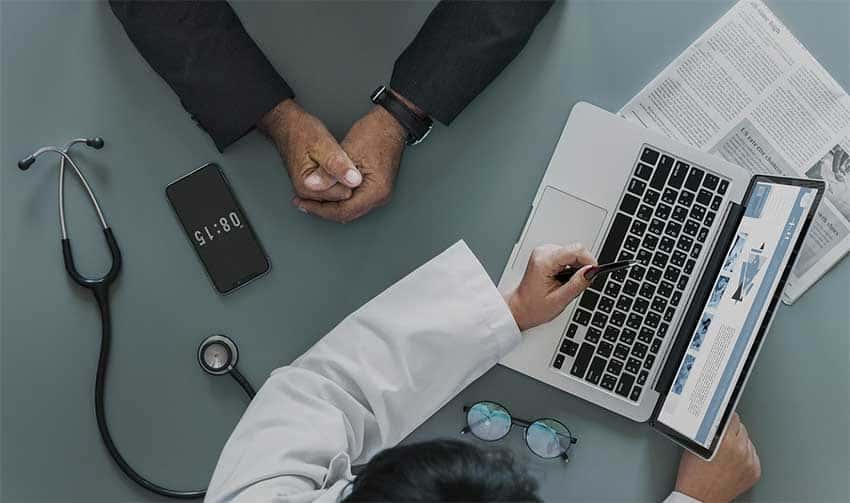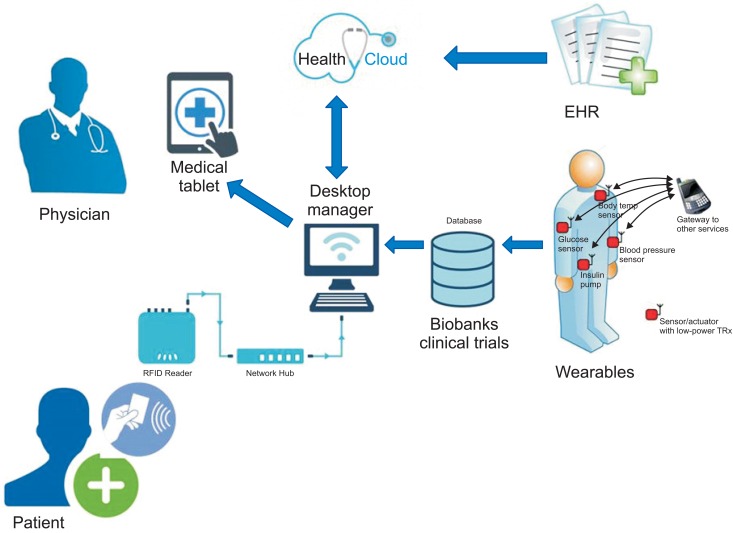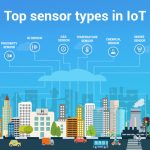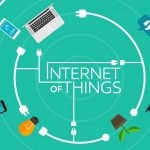The Role of IoT in Healthcare: Applications and Implementation

The healthcare field is rapidly changing with unique new technologies. But what problems are hospitals and doctors facing? There’s an increase in chronic diseases, and the global population is getting older, making it harder to provide good healthcare and help patients get better.
Healthcare providers are turning to advanced technologies like the Internet of Things (IoT), artificial intelligence, machine learning, and data analytics to tackle these challenges. Among these, the IoT has caught their attention the most.
A report by Aruba Networks, a company owned by Hewlett Packard Enterprises, found that the healthcare industry is the third most advanced in using IoT. Healthcare providers are interested in using IoT to improve their services.
So why is IoT so exciting? How can it help hospitals and doctors? Well, it allows different devices to communicate with each other and share important information. This can lead to personalized treatments, better monitoring of patients, and more efficient work.
The IoT in the healthcare industry is on the verge of significant change with these new technologies. Hospitals and healthcare providers are eager to embrace these innovations and make a positive impact on patient care. It’s an exciting time with many possibilities for improving healthcare services and making a difference in people’s lives. If you have more questions about how important is the role of IoT in healthcare, then you should read this guide to get answers to all your questions.
First thing first,
Understanding the Role of IoT in Healthcare Ecosystem
Healthcare challenges have created new requirements for healthcare providers to deliver high-quality healthcare services successfully. IoT, with its set of benefits such as enabling real-time monitoring, providing a more mature and effective solution to collect patient data, and tracking the activities of patients and staff, meet the new requirements such as.
-
- Get a better understanding of a patient’s medical condition in a series of “phases” and complex care needs
- Advanced health systems focused on the modern treatment approach and healthcare delivery system design
- Clinical information system to provide decision support
- A well-structured ongoing care program designed by a multidisciplinary team
- IoT in the healthcare industry is helpful at different patient and healthcare system interaction phases.
IoT in the healthcare industry proves instrumental in streamlining different phases of patient and healthcare system interaction. The first phase begins when the patient calls the hospital to book appointments or directly visit the hospital in case of emergencies.
From then on, real-time monitoring of a patient’s condition to intelligent medical devices connected to a smartphone application, healthcare providers can get the necessary health data that a physician can use to analyze the patient’s condition and plan better treatment.
Take a look at how it works.

Image Source :Medical Internet of Things in Healthcare
In the figure, you can find an RFID card assigned to a patient, wearable technology, and Electronic Health Records (EHR) provides data that is collected and stored on database management systems and then transferred to a physician through a desktop manager on their device. They can use this data for multiple purposes, from research to creating treatment approaches.
Now you have understood the role of IOT in the healthcare system, but wait, don’t stop here. Scroll below to learn more about how IoT can transform the healthcare industry. So without further ado, let’s dive in.
How Healthcare is Transforming Through the IoT Revolution
Healthcare providers can reap the benefits of using IOT in healthcare across several areas, including but not limited to:
- Clinical practices:- The use of IoT in healthcare is transforming the way healthcare providers operate. By incorporating IoT devices and technologies, healthcare professionals can automate record-keeping, enable real-time data sharing, and facilitate seamless collaboration among care teams. This leads to improved efficiency, accuracy, and patient outcomes.
- Track, monitor, and quantify:- Provide chronic patients with tools and platforms to actively participate in their healthcare management. Patients can track their vital signs, medication adherence, and lifestyle habits through wearable devices and mobile apps. This self-monitoring empowers patients to take control of their health, leading to better disease management and improved quality of life.
- Health risk assessment:- IoT-generated data can be used for health risk assessment by analyzing various health indicators and identifying potential risks or patterns. This information enables healthcare providers to implement preventive measures, personalized interventions, and targeted health education to mitigate risks and improve patient outcomes.
- Care for chronic patients:- It enables seamless data sharing among healthcare providers, ensuring continuity of care for chronic patients. By accessing the patient’s complete medical history, treatment plans, and real-time data, healthcare professionals can provide consistent and coordinated care, reducing the risk of medical errors and improving patient satisfaction.
- Research Studies:- IoT data plays a crucial role in research studies by providing valuable insights into clinical trial efficiency, performance monitoring, treatment effects comparison, and evaluation of novel therapeutics. It enables researchers to gather real-time data, analyze trends, and make evidence-based decisions to advance medical knowledge and improve patient care.
- Determine service metrics: IoT-generated data allows healthcare providers to measure service metrics, such as waiting times, appointment adherence, and patient flow. This information helps identify bottlenecks, optimize resource allocation, and enhance patient experience.
- Evaluate staffing patterns: Data collected through IOT can help healthcare organizations evaluate staffing patterns by analyzing patient flow, resource utilization, and operational efficiency. This information assists in determining the optimal composition of the healthcare workforce, ensuring adequate staffing levels, and improving patient care delivery.
The Internet of Things in healthcare has brought significant developments in chronic patient care management and caregiver support that have ushered in a new era of proactive healthcare delivery.
Several proven IoT use cases in healthcare, from wearable technology to advanced analytics, have produced exciting results in chronic disease management.
Implementation of IoT in the Healthcare Ecosystem
An effective care model demands IoT applications be applied to various diseases in different healthcare settings. By implementing IoT in healthcare solutions, healthcare providers get invaluable data, which provides insight into the symptoms and patterns of the disease while enabling remote care.
However, the implementation of IoT in Healthcare is still a challenge. Many healthcare providers are either not ready for investment in the Internet of Things or need the healthcare infrastructure supporting IoT implementation.
And some of them need more confidence in the implementation process. We have answered a few questions so they can take actionable measures confidently. So let’s take a look at it.
1. Is IoT effective in addressing challenges faced by healthcare providers?
The importance of IoT in healthcare lies in the fact that it plays a critical role in mitigating healthcare challenges. Healthcare solutions should not be generic, as each patient has a different physical and mental build.
By using IoT in a care-setting environment, healthcare providers can offer personalized solutions based on the lifestyle and medical history of the patient for effective treatment.
The article, The Internet of Things in the Healthcare Industry, published in Deloitte, reveals that remote patient monitoring is expected to save USD 200 billion in healthcare costs globally over the next 25 years by eliminating unnecessary visits.
2. In which segment of healthcare IoT can be applied?
IoT applications in healthcare offer unique benefits to patients, physicians, caregivers, and healthcare stakeholders. This transformative technology has immense potential to revolutionize the healthcare industry, enhancing patient care, optimizing workflows, and improving outcomes. Below you can see the categorization.
- IoT for patients: Today, chronic patients seek more information to prevent, manage, and control the disease. Patients can use wearables such as fitness brands and wirelessly connected devices to track their physical activity and make a decision that improves their health behavior.
- IoT for physicians: Physicians can access the data collected from the wearables and other medical devices to keep track of patient’s health by identifying the best treatment process, adherence to treatment plans, and achieving the expected outcome.
- IoT for healthcare providers: IoT sensors can be installed on several medical equipment, such as wheelchairs, defibrillators, nebulizers, oxygen pumps, and other monitoring equipment, which can be used for effective asset management.
- IoT for healthcare insurers: Data captured from monitoring equipment can be used to detect fraud claims and maintain transparency between patients and healthcare insurance companies.
IoT-captured data can be applied to various operational processes and patients, which can be used to check the underlying conditions and make the right decision. At which section of your healthcare process IoT can be implemented is your decision, which should depend on what kind of data you need to improve patient outcomes.
3. What medical devices can be connected using the healthcare IoT solution?
IoT medical device integration includes a range of intelligent connected devices, which can be used to monitor patients’ health and raise the alarm before the onset of any disease. In the healthcare ecosystem, the Internet of Things can be applied to the following:
- Wearables to monitor the health condition of chronic patients, take readings, observe patterns, and send an alert. This data can be used for diagnosis, improve treatment, and enhance customer service.
- Active and passive labels are to be worn by the patient, caregiver, and equipment and integrated into the equipment, hospital staff, and patient ID card to reduce admission time and facilitate better management of the resources.
- Medical devices track the equipment used for each patient and compare the data to gain insight and check their status.
These wearables and labels integrated with real-time location tracking systems can help healthcare providers do the needful quickly.
3. Precisely what type of data can be collected?
Multiple types of data can be collected through IoT. Here you can take a look at the kind of health data.
This is a broader picture of IoT data. You can develop a data model for your application of IoT in Healthcare by focusing on the dynamics of your healthcare environment to improve the quality of care for patients.
4. Where is the medical data collected from the IoT gateways stored?
Medical data collected from IoT gateways is stored on-premise or cloud servers. The choice of storage depends on your specific needs and requirements. You can consult with your IoT application development company to determine the most suitable server type for your data storage.
Depending on the nature of the data and its structure, you may opt for SQL or NoSQL databases to store and manage IoT-generated medical data effectively.
5. What about the security of IoT systems?
Cybersecurity is one of the biggest IoT challenges, but security concerns and issues could be appropriately addressed. Ensuring end-to-end security for IoT devices and applications in context with data should be handled during the application design and development phase.
While building an application, the solution provider must consider the security measures required for sensors and applications both. Besides, regular security updates and patches should be part of the process.
6. How cost-effective is it to implement IoT healthcare solutions?
The bottom line of IoT in healthcare is to ensure healthier patients, empowered healthcare providers, and cost-saving for both. You can build a cost-effective IoT sensor network with a reliable technology partner.
There are certain fundamentals to cost efficiency that can be applied in IoT development for healthcare, such as reduced overspending, the well-defined role of sensors and their capabilities, and sending and receiving data when necessary. To do all this, you must create an effective IoT development strategy and application architecture in collaboration with your technology partner.
The Final Verdict
Integration of IoT in the healthcare ecosystem presents immense opportunities for transforming healthcare delivery. By addressing the challenges faced by healthcare providers, IoT can revolutionize patient care, improve outcomes, and enhance operational efficiency.
To harness the full potential of IoT in healthcare, collaborate with Finoit Technologies, which stands as a leading healthcare application development company excelling in providing a different range of services, including IoT app development. With a team of skilled and experienced developers, we have successfully delivered cutting-edge IoT applications to clients worldwide.
To know more about how IoT can revolutionize healthcare, contact us at info@finoit.com. Together, let’s shape the future of healthcare through innovative and connected technologies.
Need Help With Healthcare
Application Development?
- Proven
- Transparent
- Dependable

